Sniper craft basics
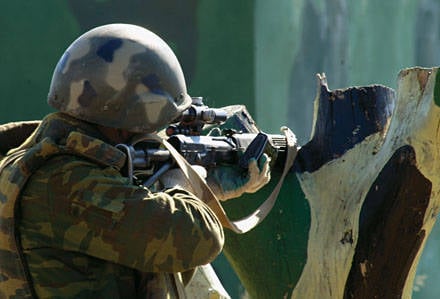 Sniper tactics
Sniper tacticsToday, most armies have two basic concepts of sniping:
1. Sniper pair or single shooter work in the “free hunting” mode, i.e. Their main task is to destroy the enemy's manpower on the front line and in the near rear.
2. The sniper reconnaissance patrol, consisting of four to eight shooters and two observers, binds the actions of the enemy in his area of responsibility and collects information about the organization of the front edge of the enemy. If necessary, this group can be enhanced by a single machine gun or grenade launcher.
To perform the combat missions assigned to it, the sniper must be placed in a separate, carefully disguised position. When a target appears, the shooter must quickly assess its value (i.e., determine whether it is worth shooting at this object at all), wait a moment and hit the target with the first shot. In order to produce the greatest psychological effect, it is desirable to hit targets that are as far as possible from the front line: an accurate shot “from nowhere” that hit a person who felt completely safe throws other enemy soldiers into a state of shock and stupor.
The most effective sniper operations in positional battles. Under these conditions, three basic forms of combat work are applicable:
1. Sniper (sniper group) is located among its positions and does not allow the enemy to move freely, conduct observation and reconnaissance;
2. Sniper (sniper group) are "free hunting" away from their positions; the main task is to destroy the high-ranking command, creating nervousness and panic in the immediate rear of the enemy (i.e., "sniper terror");
3. "Group Hunt", i.e. the work of a group of snipers in four to six people; tasks - disabling key objects in repelling enemy attacks, ensuring secrecy when moving their troops, imitating an increase in combat activity in a given sector of the front. In some situations it is advisable to use snipers at the company or battalion scale to apply centrally. This allows you to enhance the fire resistance of the enemy in the main battlefield.
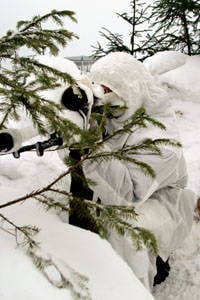 When working in pairs, one of the snipers conducts observation, target designation and reconnaissance (spotter or observer), and the other - fire (fighter). After 20-30 minutes, snipers can change roles, because long observation dulls the keenness of perception of the environment. When repelling attacks in cases where a large number of targets appear in the area of responsibility of the sniper group, and in case of a sudden collision with the enemy, both snipers fire simultaneously.
When working in pairs, one of the snipers conducts observation, target designation and reconnaissance (spotter or observer), and the other - fire (fighter). After 20-30 minutes, snipers can change roles, because long observation dulls the keenness of perception of the environment. When repelling attacks in cases where a large number of targets appear in the area of responsibility of the sniper group, and in case of a sudden collision with the enemy, both snipers fire simultaneously. Sniper groups, including 4-6 shooters and the calculation of a single machine gun (type PKM), can be used to go to the flank and rear of the enemy and cause him a sudden fire damage.
Extremely important is not only the work of the sniper himself, but also his partner - the spotter. He accomplishes the following tasks: he transports and prepares optical observation tools for work, determines the route and methods of movement, provides a sniper fire cover with an assault rifle with a rifle grenade launcher, masks and eliminates traces on the route, helps the sniper with his rifle position, monitors the terrain and compiles a report on the operation, monitors the battlefield and target designation, maintains radio communications, uses sabotage equipment ( mines and smoke bombs).
The most effective tactical reception in sniping is a long day ambush. It is held at pre-designated positions in the area of the most likely appearance of targets. The main task of the ambush is to restrict the movement of the enemy, demoralize him and gather intelligence information.
When choosing a place for an ambush, all available intelligence information should be used. In cases of enemy activity in this area, snipers must be accompanied by a cover group. Before going into an ambush, a sniper couple must specify the coordinates of his “bed”, the time and approximate routes of approach and departure, passwords, radio frequencies and call signs, forms of fire support.
The ambush is usually performed at night, so that by morning it is already in place. During the transition must be respected complete secrecy. At the ambush site, reconnaissance is performed, the position is equipped and masked. All this is done in the dark, all work must be completed at least an hour before dawn, when night vision devices begin to work for the enemy. With the onset of the day, the sniper pair begins to observe and search for targets. As a rule, in the early morning and at dusk, the soldiers lose their vigilance and can put themselves under the shot. During the observation, areas of probable appearance of targets are determined, the speed and direction of the wind are constantly evaluated, and landmarks and distance to them are outlined. At the same time throughout the day snipers must observe complete immobility and strict masking.
When targets appear, the group should quickly assess their importance and determine whether to open fire on them. Having opened fire, the sniper in many cases unmasks his “bed”, therefore, it is necessary to shoot only at the most important and clearly visible targets. Aiming at the target is usually made by both snipers: in the event of a miss, the observer will either open fire or be able to correct the shooting of his first number.
The decision on whether to remain in position further, the senior sniper pair takes after the shooting. If nothing suspicious happens on the enemy’s positions after the shot, the group may remain in position until dark. Leaving the position is carried out only at night, as imperceptibly as possible. In this case, the ambush is given its original appearance, all traces of the “bed” are carefully eliminated, in order to reuse it if necessary (although this is done only in exceptional cases). In some situations, a mine-surprise can be installed on the left position.
Especially it is necessary to talk about the tactics of snipers, serving on the roadblocks. When organizing a roadblock, it must necessarily include a group of snipers that performs specific tasks to ensure the safe operation of the post. Therefore, the position for observation and fire, which would provide the maximum sector of sight and fire, the secrecy from observing the enemy, should be chosen not only within the checkpoint, but also behind it. The specifics of the work of the checkpoint does not guarantee maximum secrecy, so the sniper must remain vigilant in order not to give himself away. To do this, he must observe the following precautions: always be prepared for the fact that the position can be monitored; do not make unnecessary movements; do not use surveillance devices without protection from direct sunlight on the lenses; keep the position natural; take a position or make a change covertly.
A circular defense is organized at each checkpoint. Therefore, snipers equip the main positions in the center of the defense area, but do not use them in their daily work. Particular attention is paid to the interaction of snipers. If there are several roadblocks in one direction, then snipers will surely organize interaction with them.
Tactics snipers in special operations
When taking hostages in buildings or houses, the first action of a special anti-terrorism unit is blocking the place of the crime. In this case, snipers are sent to the most dangerous areas, i.e. places where criminals can make a breakthrough or try to secretly leave through attics and roofs. After studying the situation: the territory adjacent to the object, the location of the premises inside the object, taking into account their rearrangements, communications (garbage disposal, heating main), and determining the location of the criminals, snipers occupy firing positions allowing them to observe the actions of the criminals without revealing themselves.
If this multi-storey building and the windows of an apartment or office where the criminals are located go to one side, then the snipers take a position opposite, but not below the floor, where the criminals are. The position is chosen so that each room is under crossfire: this allows you to view the apartment completely. If the windows are tightly curtained - you need to try to find the gaps between the curtains and watch through them.
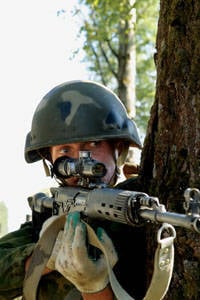 Position should be occupied in the depths of the room, the light is not included. If the curtains are light and there is an opportunity to observe through them, then they should not be touched. In the attics, positions are also sought in the depths of the room, but here it is required to ensure that the light does not fall through the slots onto the silhouette of the sniper, since it gives out during movement. On the roof, the sniper takes up positions behind the exhaust pipes, ridges of the roofs, or makes neat holes down the length of the roof to allow observation and fire.
Position should be occupied in the depths of the room, the light is not included. If the curtains are light and there is an opportunity to observe through them, then they should not be touched. In the attics, positions are also sought in the depths of the room, but here it is required to ensure that the light does not fall through the slots onto the silhouette of the sniper, since it gives out during movement. On the roof, the sniper takes up positions behind the exhaust pipes, ridges of the roofs, or makes neat holes down the length of the roof to allow observation and fire. Snipers are constantly in touch with the leader of the operation and among themselves: if one finds a criminal, the other sniper should also try to find him and determine from which position it is more convenient to hit him.
A special operation in the capture of an aircraft by terrorists is the most difficult. Aircraft have a high degree of danger if they are hit by fire, therefore the use of standard sniper rifles is limited, since when hit at a target the bullet may not remain in the body of the criminal, damaging the aircraft as well, therefore the sniper must know the design of the aircraft, the helicopter and the location of the fuel tanks and pipelines. When firing at aircraft it is impossible to use armor-piercing incendiary, with a steel core, tracer bullets.
Fire sniper opens only with full confidence in hitting the target. Such evil as "air terrorism", has now found a great spread. Therefore, special forces should devote more time to training in this direction. All airports and air terminals should be equipped so that when a hijacked plane landed, the special forces could reach it unnoticed. If there are no underground communications, then you need to use all possible options for covert approaches to the aircraft. To do this, you must have a specially equipped fuel truck for the assault team and the sniper.
At the beginning of the assault, the sniper takes up a position behind the racks of the wheels of the aircraft, covering the assault group when entering the aircraft, and then controls the actions of the group inside the cabin. He takes a position in the tail section and, using weapon under 9-mm cartridge (such as "Cypress", "Kedr", PP-93, etc.) with a target designator and a silencer, hits armed terrorists who interfere with the assault.
On the roofs and upper floors of the air terminals, observation posts or towers are equipped with a sniper. Posts and towers should be located so that when conducting surveillance it was possible to view the aircraft from two sides along the hull and from the side of the cockpit. One sniper must be with the assault group, covering it from the rear. The task of the sniper is mainly to collect information and coordinate the actions of the whole group.
When eliminating riots organized to seize power, the primary task of the snipers is to study the object of protection, identify the leaders of the group and the area adjacent to the object.
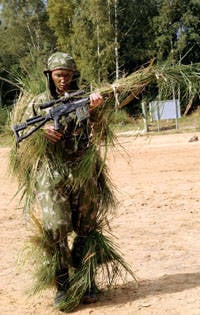 A map is drawn up of the terrain adjacent to the object and the buildings located near it, where the sectors of firing by snipers, their main and reserve positions are indicated. Places of the most possible location of the enemy's snipers, command posts, and the direction of a possible assault are also plotted on the scheme. In the object itself, firing positions at all levels of the building, taking into account camouflage, are equipped with the threat of an assault; Snipers work separately, keeping in touch with each other. It monitors, identifies the main forces of the enemy, their numbers, weapons, and also controls the movement of vehicles and people, identifies leaders and provides photo and filming of what is happening.
A map is drawn up of the terrain adjacent to the object and the buildings located near it, where the sectors of firing by snipers, their main and reserve positions are indicated. Places of the most possible location of the enemy's snipers, command posts, and the direction of a possible assault are also plotted on the scheme. In the object itself, firing positions at all levels of the building, taking into account camouflage, are equipped with the threat of an assault; Snipers work separately, keeping in touch with each other. It monitors, identifies the main forces of the enemy, their numbers, weapons, and also controls the movement of vehicles and people, identifies leaders and provides photo and filming of what is happening. During the assault, the arrows first destroy the commanders of the assault groups, leaders, snipers, grenade throwers, machine-gun crews.
In preparation for the defense of the facility, the sniper conducts the following activities:
- an exact measurement of the entire firing space is made with a mark on the diagram and certain signs are put on buildings, pavements, etc .;
- all entrances to the attic and basements of neighboring buildings are tightly clogged and collapsed, if necessary, signal mines are put up or put up, if there is an assumption that they will be used as weapon emplacements;
- in the very object of defense, the sniper personally checks all the alleged positions and outlines the places of the loopholes;
- when equipping a firing position, all objects that reflect light, chandeliers and electric bulbs are removed, if they are located above the sniper, removed.
Disguise and observation
Enough is written about the laws and techniques of disguise and observation. Nevertheless, once again about the most important. You need to watch very carefully, without losing any details. Anything that may be suspicious should be carefully examined and verified in the liability sector. However, this should be done very carefully, without giving out its location.
Disguise - it means to merge with the terrain. Among the meadows, the sniper should be grass, in the mountains - a stone, in a swamp - a hummock. Camouflage should not stand out on the surrounding background. At the same time, it is necessary to take into account the duration of the work to be done - for example, the green leaves on the cut branches will wither by the end of a hot day and will unmask the “bed”, and it will be very difficult to replace them without posing a movement.
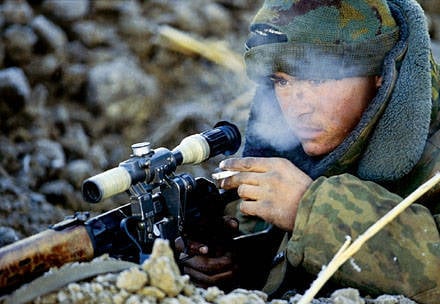 On a sunny day, the reflections from the lens of the optics — the sight and observation devices — are very insidious. This moment killed many snipers - let us remember the fate of Major Konings. In general, it is best to observe with the help of a periscope.
On a sunny day, the reflections from the lens of the optics — the sight and observation devices — are very insidious. This moment killed many snipers - let us remember the fate of Major Konings. In general, it is best to observe with the help of a periscope. In the absence of wind, the position can give off smoke from a shot, so if possible try to shoot from a small distance because of a rare bush or because of a building, a tree, a boulder. Among other things, the bullet, flying past such an obstacle, makes a sound, as if coming from a place away from the shooter.
The enemy, especially in a positional war, knows the terrain ahead of him. Therefore, each new bump, crumpled grass, freshly dug earth will inevitably cause his suspicion and will cost a sniper his life.
At dusk and at night additional unmasking factors are the flash from the shot and the reflection on the face from the eyepiece of the night sight. Also, do not use the light of the PSO optical sight grid: at dusk from the side of the lens a light bulb can be seen for a hundred meters.
Even being in your rear, you don’t need to show your belonging to a sniper group: you shouldn’t show off in front of everyone with a sniper rifle and equipment, since the enemy is watching everything that happens in your camp. The sniper is the worst enemy for him, to destroy him has always been and will be the number one task for him.
Another excerpt from Zaitsev's notes: “Each exit on a position should be provided with strict camouflage. The sniper, who can not observe disguised, is no longer a sniper, but just a target for the enemy. He came to the front, masked, lay with a stone and watch, study the terrain, make a card, put special signs on it. If, in the process of observing, you showed yourself with some careless movement of your head, opened up to the enemy and did not have time to hide, remember, you made an oversight, for your mistake you will receive a bullet only in your head. That is the life of a sniper. ”
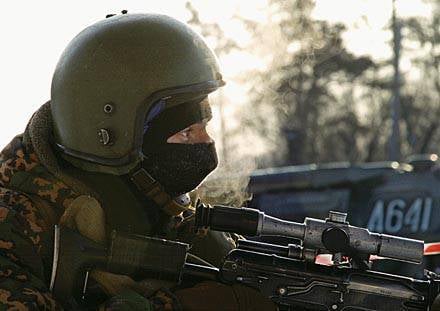 Weapons and applied ballistics
Weapons and applied ballisticsIn connection with the tasks assigned to the shooter, a modern sniper rifle must ensure the defeat of a live target at distances up to 900 meters, with a high probability (80%) of hitting the first shot at the waist target at distances up to 600 meters and in the chest - up to 400 meters. It is desirable that at the disposal of snipers in addition to the general-purpose sniper rifle (for example, SVD) there was a combat rifle with accuracy close to the sporting weapon (for example, CB-98). Such a rifle with a special combat cartridge, while ensuring high accuracy, should be designed for special tasks. In cases where shooting is conducted over short distances (150-200 meters), especially in the city, it is advisable to use silent sniper rifles (such as BCC and VSK-94). Sniper "silent" are especially good because they allow the "hunter" to leave the position unnoticed after the destruction of the enemy target. However, a small range of aimed fire severely limits their use. The range of guaranteed destruction of the head figure (the most frequent type of target for a sniper) of both rifles is 100-150 meters. That is, it is necessary to approach the position of the enemy precisely at such a distance, and this is not always possible. At the same short distances, small-caliber rifles with an optical sight are quite suitable.
SVD, for all its merits, has not the highest accuracy. Therefore, it is preferable to use high-quality weapons (MT-116, CB-98) and ammunition for counter-sniper operations! - sniper or target. If you are forced to use only SVD, try to place a larger scope on it - for example, PSP-1 or “Hyperon” - this will increase the effectiveness of the fire and the likelihood of hitting the target from the first shot.
When developing a sniper operation, you need to carefully consider the capabilities of your weapons and ammunition. In particular, the scattering width (i.e., the distance between the centers farthest from the middle point of hit) in the cartridge with an LPS bullet at a distance of 300 meters is approximately 32 cm, and in a sniper cartridge 16-20 20х30 see this difference plays an important role. Look at the table and compare it with the average sizes of the main goals: head - 25х30 cm, chest figure - 50х50 cm, belt figure - 100х50 cm, height figure - 170х50.
The effectiveness of the OSB-96 large-caliber rifle is a moot point, since special 12,7-mm sniper cartridges are made in small batches, and the dispersion of conventional machine-gun cartridges of this caliber is too great for sniper shooting. However, when processing stationary sniper positions (pillboxes, pillboxes, sculpted models reinforced with armor-sticks), a large-caliber rifle can be very useful. Back in the years of World War II, Soviet snipers used 14,5-mm anti-tank guns to defeat protected targets and firing at embrasures.
It must be remembered that the rifle must always be adjusted, then you will not have to doubt the accuracy of your weapon. It is required to regularly check the adjustment of your weapon at the main distances of effective fire, even if no one shoots a rifle: it happens that the tip gets lost in the process of storing the weapon. Sighting is carried out only by the type of ammunition that is to be used further: different types of bullets have different ballistics, and hence different flight paths.
It is necessary to carefully study the table of average elevations of the trajectories over the line of aiming and learn it by heart. In a combat situation, always use this table, especially when transferring fire from one target to another and when shooting without rearranging the remote handwheel (using the “direct shot” method). Such a table for convenient use in a combat situation is glued onto the butt of a weapon or sewn onto the left sleeve of outerwear.
Before going out for surgery, the barrel and chamber should always be wiped dry. If there is oil or moisture in the barrel, the bullets will go higher, and when fired, there will be smoke and a bright flash - this will unmask the position.
With heavy rain and in the fog bullets also go higher, so you need to move the aiming point down.
When working on particularly important targets, it is imperative to remember that the optimal mode of sniper fire is one shot in two minutes, because the barrel should not heat up more than 45 degrees. If during the battle you have to conduct intense fire, it is worth considering that when the barrel warms up, the bullets will go lower.
If a sliding-bolt rifle is used, then when unloading it is impossible to send the bolt back too hard: this shakes the bolt and quickly wears the larva. After the shot, if there is no need to continue shooting, leave the shutter open; this will not allow the powder gases to “sweat” in the barrel and allow the barrel to cool faster.
So that the rifle barrel does not glare in the sun and is less heated in hot weather, it is wrapped with a shaggy camouflage tape, a piece of KZS mask or a usual fabric tape. Among other things, it will protect the barrel from accidental impacts.
It is necessary to regularly check the fixing strength of an optical sight: if there is no side roll, if handwheels do not rotate too freely. The quality of the fitting of the sighting mechanism and the fastening of the drums is checked as follows: they direct the central square (the tip of the hemp) at any reference point and, alternately pressing the drums, monitor the reticle of the sight. If the angle when the drums are pressed is shifted, then the aiming mechanism has large gaps and inevitably a shift of the aiming grid with each shot.
Individual scopes have some free movement of the screws. In order to determine it, the sight bracket is firmly fixed (for example, in a vice), the central square is brought to a point and the handwheel is turned several divisions to the side and back. If the scope has a free stroke of the screws, the angle will not coincide with the initial position, without reaching it. In order to compensate for the free running of the screws, all the turns of the handwheels need to be finished in the same direction, for example, clockwise. Then, if it is necessary to turn the handwheel counterclockwise, then it is shifted two or three divisions further, and then, returning to the desired risk, the aim is finally set by turning clockwise.
It is always necessary to make handling the weapon as convenient as possible: a rubber butt pad from GP-25 can be hung on the butt, folding bipods from the RPG-7 can be attached to the foreleg if desired. A regular rubber band from an expander, double-slit loops draped over the trunk, and ends tied to any vertical object (tree trunk, pole, etc.), will allow in ambush not to load the arms with the weight of the weapon.
The barrel of the rifle must be protected from dirt, dust and other foreign objects. If you have to work in conditions of high dustiness (for example, in the steppe or in the mountains), then a usual condom is put on the trunk; after the first shot, it will burn without interfering with the flight of a bullet.
The weapon requires careful attitude, so you need to clean it regularly, and most importantly - not to let anyone shoot from it.
Sometimes the situation can change quickly, targets can appear over a wide area with a range of distances and disappear quickly. In such conditions, each time to determine the distance and the more so to install a sight on them is simply unrealistic. In anticipation of such a situation (as a rule, it arises when the enemy attacks), you should target the rifle to the maximum range in its own area of responsibility (for example, meters on 400), remember a noticeable guideline in the region of this range and to focus on it in further shooting. Now you can estimate by eye how far the target is or closer to the benchmark in the “swing” value along the vertical of the aiming point. To do this, you need to be very good at imagining the trajectory of a bullet at a distance that the rifle was aimed at. It is quite simple to check the rifle's fight in the field: you can map out a reference point and make a series of shots on it - the magnitude of the deflection of bullets is determined by ricochets. However, it should be noted that such non-standard adjustment is not to be carried away: it is used only in the most urgent cases, when there is a need to hit a target from the first shot. Sighting should be masked by the noise of the battle and lead it from the reserve positions.
In high-speed shooting at short distances (up to 300 meters), as a rule, a direct shot is used, i.e. shot in which the trajectory of the bullet does not rise above the height of the target. In particular, in city conditions, the range of fire rarely exceeds 200-250 meters, therefore, by setting the 2 sight, you can make no vertical adjustments: to 200 meters, the height of the trajectory does not exceed 5 cm, which means the bullet will fall into the target; At distances from 200 to 250 meters, the aiming point should be taken higher on 10-11.
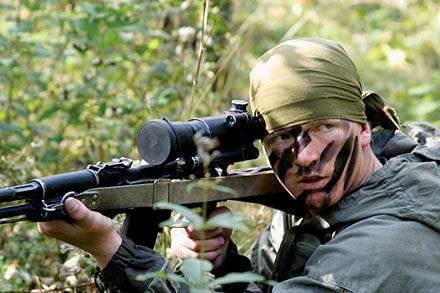 Observation
ObservationIt is necessary to master the skills of observation, to do it intensively and systematically, each time taking small sectors for study. One should not aimlessly wander the view across the entire observation area - this is a common mistake.
You need to look at everything that happens in a foreign territory, with suspicion. It is advisable to mentally transfer to the position of the enemy and think about what he could do in such conditions.
Examining the terrain in a given sector, it is possible to divide it into areas equal to the field of view of an optical sight, binoculars, or periscope. You need to work slowly and carefully, blocking the field of view.
If during the observation there was a suspicion about an object, then you need to inspect everything around it, because the sharpest part of the view is not in the center, but on the edge of the field of view of the eye. This is especially true when observed at dawn and dusk.
Slow motion is also easier to detect if you do not look directly at the object: you have to look higher, lower or slightly away from the object - then the sharpest part of the eye’s view is used.
If possible, you should try not to observe through binoculars, and use a periscope: this will protect the enemy sniper from bullets and detection.
If the observation is conducted through an optical sight in conditions of deteriorating visibility (early dusk, haze, etc.), then you should use a light filter - it is included in the SVD kit; Yellow-orange glass significantly increases visual acuity and contributes to a clearer perception of the boundaries of the contour of the object by the retina.
Often a sniper has to shoot at targets that appear unexpectedly. Under these conditions, there is no time to determine the distances, therefore, at the most likely boundaries and directions, select appreciable landmarks in advance. For them in the future and should be counted and determine the position of targets and the distance to them.
Disguise
There is no universal camouflage suitable for masking in various conditions, so you need to constantly diversify and invent new masking tools, depending on the task and the conditions for its implementation. General rules for disguise:
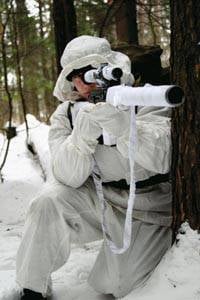 - any measures must be preceded by a thorough reconnaissance of the terrain and an assessment of it in disguise;
- any measures must be preceded by a thorough reconnaissance of the terrain and an assessment of it in disguise; - having chosen camouflage equipment, it is required to adjust it carefully, without losing the smallest details; You can ask a friend to check if there are any unmasking stains;
- taking a position in any local object, you need to use it as a shelter only from the side, but in no case from above;
- one should not choose places for the firing position near the visible landmarks: they will be examined in the first place by the enemy;
- in any case, the position must be taken so that there is a masking background behind;
- you can use the shadow of local objects, but you need to remember that during the day the shadow changes its position;
- masks vegetation well (grass, branches, etc.), but you have to take into account that it retains its natural color only for the 2-3 of the day; then the leaves will wither and will issue a position;
- for coloring the face and hands, you can use the juice of herbs mixed with the “milk” of plants such as euphorbia, - all this is kneaded in the notch of the SVD butt and then applied to the skin; however, you need to be careful in choosing herbs to avoid poisonous plants that can cause itching and even burn;
- when entering the position all traces must be carefully destroyed;
- if possible, it is necessary to take measures to eliminate the unmasking action of the shots: by equipping a position in the field, you can arrange a “bed” for a rare bush or stick a few branches three or four meters away. When fired, the smoke will remain behind them and the flash will not be so visible; when firing from a building, the position should be in the depth of the room - in this case, the flash and the sound of the shot almost do not go outside;
- here is the easiest way to make a prone position in the field: for a camouflaged parapet device, you need to cut about eight pieces of turf about 20 in size on 30 cm, while the lower, “earthen” part of the turf is cut by a pyramid, at an angle of 45 degrees; then from these bricks lay parapet grass in the direction of the enemy; at the end of the work, if there is a need to hide the place of shooting, the turf is put in place and slightly watered;
- being in position in winter, it should be remembered that the breath of steam easily unmasks the location, so you need to breathe only through a scarf or mask. So that the snow does not shoot up when fired, you can sprinkle the snow before the “laying” of water from a flask;
- moving around the area, it is necessary to make maximum use of vegetation and all kinds of shelter.
- leaving the firing position, you can not take it immediately: you must first crawl, stopping not far away and carefully looking around, - the position can be mined or there may wait an ambush;
- you should always keep in the lowlands, never go to open spaces and the horizon line; whenever possible bypass all places where enemy observers can notice the sniper;
- movement should be minimized; quick movement with a hand or foot is very dangerous; but in some cases, while maintaining complete immobility, you can be invisible, being almost at the very sight;
- it is necessary to master the art of walking, so that the effort goes from the hip, and not from the knee; first, the ends of the fingers and the front of the foot should be placed on the ground; the heel usually produces noise, especially where there are stones, branches, etc.
- in wet weather and in a light fog, the shot gives a particularly strong position of a sniper (however, an improved view is possible in wet weather);
- if possible, work better in a pair with a machine gunner: he will drown out your shots with bursts and cover him in case of a sudden departure.
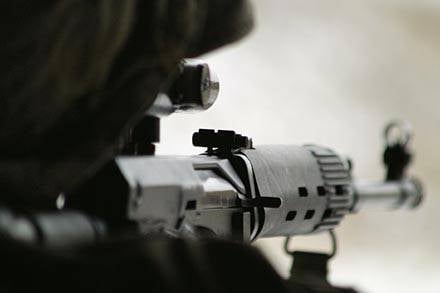 Vision
VisionWe must constantly remember that the eyes - the main tool of the sniper. Ideally, the vision should be excellent, but in principle some reduction in its sharpness is acceptable, but with the obligatory use of glasses or contact lenses.
In order to maintain good vision under heavy loads, eyes need support. Here are simple exercises for the prevention of vision (from the experience of athletes-shooters).
1. Tighten your eyes tightly for 3-5 seconds, then hold your eyes open 3-5 seconds; repeat 8-10 times (this strengthens the muscles of the eyelids and improves the blood circulation of the eyes).
2. Massage closed eyes with circular movements of a finger for a minute (this relaxes the muscles of the eyes and improves their blood circulation).
3. Extend your hand forward and look at the tip of your finger, then slowly bring your finger closer, never taking his eyes off him until he begins to split in two; repeat 6-8 times (this strengthens the oblique muscles of the eyes and facilitates visual work).
After a strong load on the eyes, you can apply lotions from weak tea brewing or sage decoction: moistened warm tampons are applied to the eyes and hold until they cool down.
Precise Shot Secrets
Making an accurate shot requires the sniper to perform certain actions - making, aiming, holding the breath and lowering the trigger. All these actions are obligatory elements of the well-aimed shot and are in a definite, strictly coordinated relationship with each other.
In order for the shot to be accurate, first of all the shooter needs to ensure the greatest immobility of the weapon during its production. Manufacture and must solve the problem of giving the greatest stability and immobility of the entire system consisting of the body of the shooter and weapons. Since the very meaning of sniper shooting is to hit a small target at a great distance, it is clear that the shooter must give the weapon a strictly defined direction, i.e. point it at the target; This is achieved by aiming. It is well known that breathing is accompanied by rhythmic movement of the chest, abdomen, etc. Therefore, in order to ensure the greatest immobility of the weapon and to maintain its direction, achieved as a result of aiming, the shooter must hold his breath for the duration of the shot.
If the sniper is you, then to fire a shot, you need to use your index finger to pull the trigger; in order not to dislodge the weapon aimed at the target, it is necessary to press the trigger smoothly. However, due to the fact that you can not achieve complete immobility during manufacture, the trigger must be released in conditions of greater or lesser oscillation of the weapon. Therefore, to achieve a well-aimed shot, it is necessary to press the trigger not only smoothly, but necessarily strictly in accordance with the aiming.
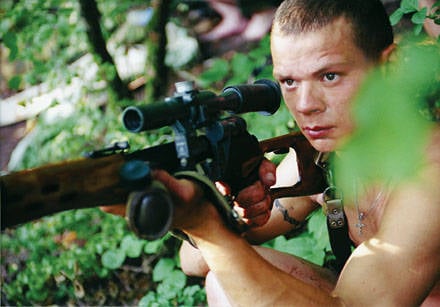 We will try to make out in isolation the main elements of an accurate shot.
We will try to make out in isolation the main elements of an accurate shot. Currently, in combat shooting there are a variety of types of manufacturing. When shooting with a sniper rifle, four main types are used: lying, sitting, with a knee and standing.
Considering the direct dependence of shooting accuracy on the degree of immobility of the weapon during firing, the sniper should pay serious attention to the selection for himself of such a make that provides the best stability and immobility of the gunner-weapon system. In addition, the “super-archer” should always be faced with the task of selecting such a rational posture (for each type of workmanship) in which keeping the body with the weapon in the same position will require the most economical expenditure of physical strength and nervous energy. Therefore, despite the abundance of possible options, in general, the manufacturer should provide:
- the necessary degree of equilibrium of the “shooter-weapon” system;
- achieving the balance of this system with the lowest voltage of the muscular apparatus of the shooter;
- the most favorable conditions for the functioning of the sensory organs, primarily the eyes and vestibular apparatus;
- conditions for the normal functioning of the internal organs and proper blood circulation.
Of course, you need to make an amendment to the specific conditions of sniper work (in some situations it is simply impossible to make the correct workmanship), however, in general, the laws of manufacture are the same for everyone.
Since each person has individual physical characteristics, it is natural that there is no template or universal recipe in manufacture that would suit all shooters. This means that the sniper himself must, in accordance with his physical features, select for himself the best manufacturing options for various conditions.
Sometimes it is necessary to search for the most convenient variants of manufacture for a long time and unsuccessfully, every shooter knows about it. In order not to go the wrong way and not waste time, the novice shooter must look closely and carefully study the shooting technique of experienced snipers, adopting everything valuable and useful. At the same time, there is no need to blindly copy any one version of manufacture; should approach this from the standpoint of common sense.
In a combat situation a sniper often has to fire in very difficult and uncomfortable conditions. However, despite this, he should try to be made for firing in such a way that his position maximally ensures the possibility of accurate fire from the chosen position. Not only the results of shooting, but also comfort during a long stay on a masked "lie" depend on the correct and comfortable position.
Of course, the most advantageous position for shooting - lying, using the stop. The use of the stop greatly facilitates the shooting conditions; in addition, it contributes to better disguise and covers the enemy from fire.
As a stop, it is best to use as much soft material as possible - turf, a bag of sand or sawdust, or a backpack. The height of the stop depends on the body build, therefore the sniper must adjust the stop to himself.
Usually recommend two ways to use the stop when shooting. The main one is when the rifle does not touch the support, but lies on the palm of the left hand; at the same time the forearm and arm are on the support, and the elbow (left) rests on the ground. This method is especially beneficial if the support is hard. However, it’s difficult to stay in this position for a long time, therefore, if you are in a position for a long time, I recommend another technique: the rifle is placed directly on the support with its part at gunpoint, and the butt is supported by the left hand from the bottom of the left shoulder. In this case, the hands form a kind of "lock" that ensures reliable retention of the weapon.
The rifle is applied at four points: the left hand on the forend, the right hand on the pistol grip (butt neck), the butt pad - in the shoulder notch, the cheek on the butt rest. This method of holding was not chosen by chance: it is only in this way that the rifle is fixed securely when aiming and firing, without trembling and collapsing arms to the side. Almost all muscles, with the exception of those directly involved in shooting, remain relaxed. When firing for fixing the system "shooter - rifle" can be used a gun belt. It is desirable to apply the belt at all positions - lying, sitting, from the knee, standing, except when it is possible to use the stop. When firing from the SVD and AK-74 with an optical sight, the belt is passed through the forearm and thrown over the magazine. The tension of the belt should be such that the weight of the weapon falls on the tensioned belt, but at the same time the left hand should not leak. During training, the shooter must find for himself the most convenient and comfortable position of the belt on the arm and the degree of its tension. In order to make it easier and faster to find the right position of the belt, you can sew a large hook on the left sleeve of the outerwear (for example, from the overcoat) - among other things, the hook will prevent the belt from sliding. On the belt itself, it is best to make tags that correspond to the position of its buckle at the most convenient length.
Making a shot, it is very important not to "pull" the weapon. To do this, grip the pistol grip (neck of the butt) tightly, but effortlessly, press the trigger with the first joint of the index finger, while moving the finger smoothly back and forth parallel to the axis of the barrel. Finish the processing of the descent should be immediately after pointing the weapon at the point of aiming.
Compared to other types of production, the manufacture for prone shooting is the most stable, since the body of the shooter lies almost completely on the ground and both elbows rest on the ground. The large surface area of the body of the shooter with a small height of its center of gravity makes it possible to create the most stable equilibrium of the “shooter-weapon” system.
Most importantly, the manufacture lying down should provide not only a good stability of the rifle with the lowest tension of the sniper’s muscles, but also a long stay of the body in the same posture during firing, and a position of the head that will have the most favorable conditions for the work of the eye during aiming.
The difficulty in finding a convenient and correct construction for oneself is that the requirements mentioned above are not only interrelated, but also in some contradiction. For example, if you increase the body turn to the left, then it will be easier to breathe, but the conditions for application and work of the leading eye will deteriorate during aiming. If you begin to carry out the left hand, the supporting weapon, as far as possible ahead, the ready will become lower and, naturally, more stable; but at the same time the conditions for breathing will worsen and the load on the left arm will increase, which leads to rapid fatigue of her muscles.
Based on all this, the sniper must find for himself the most acceptable option for the manufacture, taking into account the peculiarities of his physique.
The stability of the manufacture and the duration of the body of the shooter in the same position depend primarily on the body position, and in particular - on the orientation of the body relative to the plane of fire. Practice has shown that it is best to turn the body towards the plane of fire at an angle of 15-25 degrees. With such a turn, his position will be comfortable, his chest is not very constrained, which means that his breathing is relatively free. At the same time there will be favorable conditions for application and aiming.
By the way, in contrast to the standard manufacture, recommended by all the instructions, the so-called “Estonian” manufacture turns out to be quite convenient for high-speed shooting. With her right leg bent at the knee, the shooter himself does not lie flat on his stomach, but a little on his left side. In this position, the chest is not constricted, breathing is deeper, it becomes easier to reload the weapon and work with the optical sight handwheels.
Shooting from the knee by snipers is most often used when conducting combat in city conditions, when the shooter carries out firing cover for assault groups. In such conditions, the fire is conducted from short stops, when there is no time to comfortably lie down. Just as in the manufacture of prone, it is desirable to use a gun belt.
The left leg should be strictly under the left elbow, the elbow rests on the knee. At the same time, the elbow of the right hand should not be set aside; on the contrary, it is better to press it against the body.
You can shoot from the knee, for example, in thick tall grass covering the view in the prone position, but you need to remember that for very accurate shooting, as well as for a long stay in this position, this fabrication is not suitable.
Shooting sitting is not very common in our country, although in the Western armies it is very respected and practiced a lot. There are two variants of such a make: sitting in Turkish and Bedouin. When firing sitting in Turkish, the sniper presses his legs under him (probably everyone knows how to sit in Turkish), the foot of one foot is passed between the thigh and shin of the other, and the elbows rest on the knees or, if it is more convenient, drop by the knees.
In the Bedouin way, the shooter sits with his legs wide apart, bent at the knees, heels resting on the ground (so that the legs do not slide when fired), and the elbows, as in the previous case, rest on the knees.
Both methods are quite stable and convenient, after some training, so you can sniper fire, even with some comfort. However, in both positions it is difficult to sit for more than half an hour (especially in Turkish) and it is difficult to move from them quickly and unnoticed during an emergency change of position.
Shooting from a rifle while standing as a make for a sniper is the last thing to do, because it is very difficult to perform and, most importantly, unstable. But if you still have to stand up from a sniper rifle in some difficult circumstances, then, firstly, use a belt (in the old version); secondly, hold the rifle on the pads so that the magazine rests on the left hand just below the brush; and thirdly, do not complicate the situation and try to find some vertical object (tree trunk, corner of the building) in order to rest on it with your left forearm.
How to aim, using an optical sight? The optical sight device provides for aiming without the participation of the front sight and the slot of the sight mounted on the rifle barrel, because the line of sight in this case is the optical axis of the sight passing through the center of the lens and the tip of the central angle of the sight grid. The sighting grid and the image of the observed object (target) are in the focal plane of the lens, and therefore the sniper's eye perceives the target image and the grid with the same sharpness.
When aiming with an optical sight, setting the head of the arrow should be such that the line of sight passes along the main optical axis of the sight. This means that you need to combine the eye with the exit pupil of the eyepiece and then bring the tip of the angle to the point of aiming.
The eye should be from the outer lens of the eyepiece at a distance of removal of the exit pupil (eye distance). Depending on the design of the sight, this distance is equal to 70-80 mm, it is necessary for the safety of the recoil of the weapon.
While aiming the shooter, it is necessary to carefully ensure that there are no blackouts in the field of view, it must be completely clean.
If the eye is closer or farther than the eye’s distance, then a circular obscuration is obtained in the field of view, which reduces it, interferes with observation, and complicates aiming. However, if the blackout is the same on all sides, then there will be no bullet deviations.
If the eye is located incorrectly relative to the main optical axis of the sight - shifted to the side, then moon-shaped shadows will appear at the edges of the eyepiece, they can be from either side, depending on the position of the axis of the eye. In the presence of moon-shaped shadows, bullets will deviate in the opposite direction to them. If you notice shadows while aiming, find a position for the head in which the eye will clearly see the entire field of view of the sight.
In other words, in order to ensure accurate aiming with a telescopic sight, the sniper should direct all attention to keeping the eye on the optical axis of the sight and combining the central angle with the aiming point.
Trigger technique is of great, and sometimes crucial in the production of a shot. Firstly, the trigger release should not dislodge the weapon aimed at the target, i.e. should not shoot down a tip; for this, the shooter must be able to very gently pull the trigger. Secondly, the trigger release must be carried out in full accordance with the visual perception, i.e. to coincide with a certain moment when the “smooth front sight” is at the aiming point.
This means that in order to achieve an accurate shot, a sniper must perform two actions — aiming and a smooth pull on the trigger — strictly in agreement with each other.
However, a difficulty arises: when aiming, the weapon is not fixed, it always fluctuates continuously (depending on the stability of the gunman). As a result, the “smooth front sight” constantly deviates from the aiming point. The shooter must complete a smooth descent at the exact moment when the center square of the reticle is at the aiming point. Since rifle oscillations of many, especially untrained shooters, are arbitrary, it is very difficult to predict when exactly the square will pass through the desired point. Skill in the production of descent and is to develop skills aimed at improving the consistency of movements and monitoring their implementation.
Regardless of what type of descent the shooter will use, it is very important that he observes the basic requirement: the trigger must be lowered so as not to knock down the tip, i.e. very smoothly.
The production of a smooth descent imposes special requirements on the operation of the index finger when pressing the trigger. The quality of the shot largely depends on this, because the most careful and fine aiming will be broken at the slightest wrong finger movement.
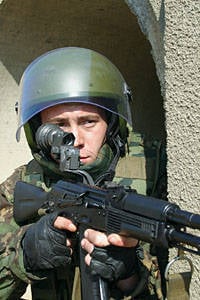 In order not to violate the tip, the right hand should correctly cover the neck of the butt (pistol grip) and create the necessary support so that the index finger can overcome the pull of the trigger. Covering the grip should be sufficiently tight, but without unnecessary effort, because the muscular tension in the hand will entail an increased oscillation of the weapon. In addition, it is necessary to find a position for the brush so that there is a gap between the index finger and the handle. Only then the movement of the finger when pressing the trigger will not cause side shocks, displacing the weapon and knocking down the tip.
In order not to violate the tip, the right hand should correctly cover the neck of the butt (pistol grip) and create the necessary support so that the index finger can overcome the pull of the trigger. Covering the grip should be sufficiently tight, but without unnecessary effort, because the muscular tension in the hand will entail an increased oscillation of the weapon. In addition, it is necessary to find a position for the brush so that there is a gap between the index finger and the handle. Only then the movement of the finger when pressing the trigger will not cause side shocks, displacing the weapon and knocking down the tip. Pull the trigger should be the first phalanx of the index finger or the first joint - only such pressing requires the least movement of the finger. It is necessary to press so that the index finger moves along the axis of the bore, straight-back. If you begin to press a little sideways, at an angle to the axis of the bore, this will lead to an increase in the tension of the trigger and an abrupt movement of the trigger caused by a bias. This can also bring down the tip.
To produce an accurate shot, a sniper must learn to increase the pressure on the trigger smoothly, gradually and evenly. This does not mean slowly, but exactly smoothly, without jerks. The descent should take from 1,5 to 2,5 seconds.
In addition, it is necessary to press the trigger not only smoothly, but also in time, choosing the most favorable moments when the rifle oscillations will be minimal.
The system of "shooter - weapon" during the aiming and shooting is experiencing difficult fluctuations. The reason for this is the action and reaction of the muscles while working to hold the body of the shooter in a certain position, as well as blood pulsation. At the beginning, when the shooter makes a rough guide and has not had time to properly balance the weapon, the fluctuations will be large. As the sighting is refined, the oscillations of the arms somewhat subside, and after a while, when the muscles begin to tire, the oscillations increase again.
From this it is seen that in such circumstances it is necessary to begin a smooth pressing of the trigger during the period of coarse aiming of the weapon; then, refining the aiming, smoothly increase the pressure on the descent, trying to complete it at that moment when the rifle is experiencing small vibrating oscillations or stops at all.
Adverse lighting conditions greatly complicate aiming. The sniper's eyes are blinded by the sun, snow cover on a sunny day, excessively bright illumination of targets, sun glare on the surfaces of weapons and sighting devices. In such conditions, an unprotected eye is irritated, tears protrude, a stinging, involuntary squinting appears - all this not only makes it difficult to aim, but can lead to irritation of the mucous membrane and eye disease. Therefore, the sniper should take care of creating favorable conditions for the work of the eye while aiming and maintaining its vision.
When shooting with a PSO-1 telescopic sight, it is necessary to protect the objective part of the sight from the sun with a retractable hood and the eyepiece with a rubber eyecup. The hood and eyecup protects direct and lateral sunlight from contacting the lens or the eyepiece, causing reflection and light scattering in the lenses of the sight, which makes it difficult to work with it.
So that the surface of the barrel does not shine, you can stretch a cloth tape over it, but it is best to just wrap it with a shaggy camouflage tape - this will remove the luster and mask the weapon.
To protect the eyes from bright sunlight, you can successfully apply the visor of a field cap.
In those cases when the targets are very bright, you must use a light filter, putting it on the eyepiece of the sight. The yellow-orange light filter, included in the PSO-1 kit, well eliminates the violet part of the spectrum, which contributes to the formation of obscure images on the retina. In addition, periodically let us rest our eyes, staring into the distance — this is simple and effective.
In conclusion, we can formulate the basic rules for accurate rifle shooting with an optical sight.
Always tightly “insert” the butt into the shoulder and use the stop monotonously: if you do it every time in a new way, then due to the variety of departure angles, the dispersion of bullets in the vertical plane will increase. Remember that when the butt is pressed against the shoulder, the lower corner of the bullet goes higher and the upper angle goes lower.
When the left elbow is displaced during the production of a series of shots, the individual holes are broken down and up, and there will be as many times as you have shifted your elbow.
When preparing to shoot, do not put your elbows very wide; Such an arrangement of elbows violates the stability of the rifle, tires the arrow and entails the spread of bullets. However, a too narrow position of the elbows compresses the chest and hampers breathing, which also degrades the accuracy of shooting. If you lift the butt with your right shoulder at the time of the trigger or press your cheek too hard against the butt, then the bullets are deflected to the left.
Sometimes the shooter, having accepted the wrong turn of the body in relation to the target, tends to direct the rifle at the target with the muscular effort of the hands to the right or left. As a result, when shooting a muscle, the rifle is weakened, and hence the bullets are deflected in the direction opposite to the applied force. The same is obtained if the sniper will use his hands to raise or lower the rifle to the aiming point. It is quite simple to check the direction of the weapon at the target: aim the rifle at the target, close your eyes, then open them and see where the aiming line has deviated. If the aiming line is deflected to the right or left, move the entire body to the right or left, respectively; when the weapon is tilted up or down, without moving elbows, move forward or backward, respectively. The stability of the rifle is ensured by the correct position of the arms, legs and body - with an emphasis on the backbone, but not at the expense of large muscle tension.
The accuracy of shooting affects when you pull the cheek from the butt when you pull the trigger. In this case, you still lose the line of sight. Such a habit leads to the fact that over time you will begin to raise your head before the drummer breaks the cartridge's cap. Train yourself to keep your head free and your cheek tightly attached to the left side of the butt, but without tension. Also, get used to having a certain amount of time
(2-3 seconds) maintain the position of the aiming line.
The rifle should not lie on the fingers of the left hand, but on the palm - so that the palm was turned with four fingers to the right. At the same time, the thumb should be on the left, and the other four should be on the right. If the rifle lies on the fingers, then its stability is broken and the bullets go to the right and down, i.e. there is a stall of weapons. The fingers of the left hand should not squeeze the forearm tightly, you need to hold the weapon like a bird - gently so as not to strangle, but firmly so that it does not fly away.
The position of the body at the time of manufacture for prone shooting should be free, without the slightest tension and without bending in the lower back. The bending of the body causes tension in the muscles, as a result of which the correctness of the application, the position of the arms, etc., are disturbed, and as a result, the dispersion of bullets increases. Incorrect position of the body is corrected by moving the legs to the left or right.
Removing the eye of the shooter from the eyepiece of the optical sight should be constant, depending on the physique. Approximately it should be 6-7 centimeters (in accordance with the design of the sight).
Remember a simple thing: when you press the trigger, you must hold your breath. Some novice arrows for this gain air, and then produce a trigger, although this creates a general stress shooter. You will become accustomed to observe such a breathing mode: having caught the air and exhaled almost all of it, hold your breath and only then begin to pull the trigger, i.e. the shot must happen as you exhale. The first seconds after a breath hold are the most favorable for firing a shot.
Some shooters do not respond correctly to the inevitable small fluctuations of the central angle of the optical sight near the aiming point: they are trying to fire at the exact moment when the edge of the angle will align with the aiming point. As a rule, in this case, there is never a smooth descent and there are sharp tears of bullets. Wean yourself from this habit: such fluctuations have very little effect on the accuracy of the shot.
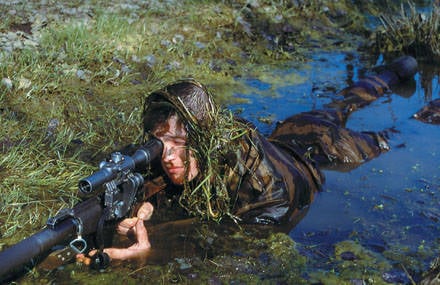 Affected area
Affected areaIt is generally accepted that the sniper's calling card is a headshot. This is justified, since a bullet hit any part of the skull leads to damage to the brain as a whole due to hydrostatic shock. Damage to the skull leads to very serious consequences, which result in loss of consciousness and cessation of all vital functions. If a bullet hits the face, then the brain or spinal cord is usually affected; when shot in the back of the head, the central part of the brain is affected and the person immediately falls.
However, in some situations, the sniper has to shoot from a distance, when it is difficult to aim carefully at the head. In addition, the head is the most mobile part of the human body, and getting into it is not so easy. In this case, the aiming should be made in the central part of the body of the enemy. There are three of the most important areas of damage - the spine, the solar plexus and the kidneys. Closer to the central axis of the body (i.e., to the spine) are large blood vessels - the aorta and vena cava - as well as the lungs, liver, kidney, and spleen. When it enters the spine, the spinal cord is affected, which most often causes paralysis of the legs. The solar plexus is located directly under the rib cage, getting into it causes severe damage to the internal organs, while the person is sharply bent in the belt. A shot in the kidneys leads to shock, and then to death, because nerves are concentrated in the kidneys and there are a large number of blood vessels. A rifle bullet into the human body causes a hydrostatic shock because a pressure wave is formed due to the displacement of water-saturated tissues. The result is a temporary cavity that is many times larger than the size of the inlet. A pressure wave can cause damage to internal organs that are not directly hit by a bullet.
In addition, another result of a bullet hit is the formation of secondary fragments - particles of fragmented bones. These fragments affect the internal organs, moving along different trajectories. This moment is especially important to remember the snipers of special units when conducting operations to free the hostages, because a hostage who is very close to a terrorist can be injured by secondary bones. In such conditions it is advantageous to make a shot at the moment when the terrorist is behind the hostage, and not in front of him or from the side.
On the other hand, an army sniper can only injure his victim, because then several enemy soldiers will be forced to engage the wounded, and perhaps one of them will be substituted for the shot; in addition, the appearance of the wounded at the position undermines the enemy's morale.
In addition to other characteristics of the weapon, a professional sniper should know what the stopping and killing effect of a rifle bullet is. The stopping action is the ability of a bullet to immediately disable a living target; slaughter effect - the possibility of inflicting fatal damage to the enemy. It is usually considered that the minimum kinetic energy of a bullet of a normal caliber, necessary for putting the enemy out of action, must be at least 80 J. For a SVD rifle, the range at which the bullet retains such destructive power is about 3800 meters, i.e. far exceeds the aiming shot.
The area of the human body, with the defeat of which the probability of instant death will be as high as possible, is approximately 10% of the entire body surface (when using conventional ammunition).
At one time, American military doctors, following the Vietnam War, found that when using conventional rifle ammunition, death occurs with a head injury - in 90% of cases; with lesions of the chest - in 16% of cases; if the bullet hits the heart region, death occurs in 90% of cases; if it enters the abdomen - in 14% of cases (subject to the provision of timely medical care). The head is the most vulnerable part of the human body in terms of wound ballistics. A bullet hit such parts of the brain as the medulla oblongata and the cerebellum leads to the death of the victim in almost 100% of cases - if they are damaged, breathing stops immediately, blood circulation and the human neuromuscular system are paralyzed. In order to hit the enemy with a bullet in the cerebellum area, you need to aim at the upper part of the nose bridge. If the target is deployed sideways - under the base of the ear. In cases where the enemy is standing with his back, - at the base of the skull. However, some snipers consider the zone between the nose and the upper lip to be the most advantageous point - the bullet destroys the upper part of the spinal column, causing a severe wound, in most cases incompatible with life. Nevertheless, the head is only one-seventh of a person's height in size, so it’s very difficult to get into it from a long distance.
In general, the most effectively affected part of the human body is bounded above by a line that runs two fingers below the level of the clavicles and below it is two fingers above the navel. A bullet wound to the abdominal area below this zone leads to a painful shock, and failure to provide timely medical care and death, but in most cases does not deprive the enemy of the ability to resist immediately after the defeat - this is a particularly important point for anti-terrorist unit snipers.
Information